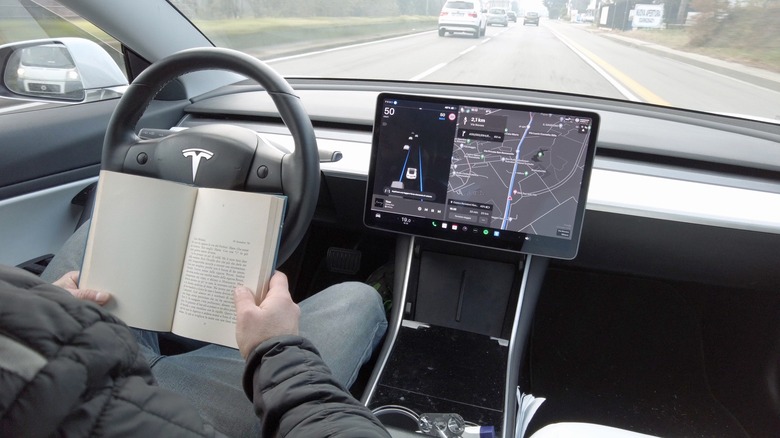The One Question Autonomous Driving Advocates Still Need To Answer
Autonomous driving has advanced from the spring-powered cart invented by Leonardo Da Vinci around 1500 to a five-level classification that ranges from 0 (no or minimal autonomous features) to 5 (completely self-driving). Cars on the market today don't offer more than level 4 autonomous driving, and most sit at about level 2. The delay in the development and availability of fully autonomous vehicles has been in part due to the highly publicized accidents involving autonomous vehicles, which caused 18 deaths as of February 2023 (though it remains unknown if autonomous systems had a part in all of the accidents).
All of those fatalities have been caused by cars operating at level 2, with 17 of those 18 deaths caused by Tesla cars as of about a year ago. These rare but well-known incidents are one obstacle to the adaptation of autonomous driving technology, but there's another issue at hand that isn't specific to any single manufacturer, according to Dr. Laine Mears, the Automotive Manufacturing Chair at Clemson University's International Center for Automotive Research.
Autonomous driving has yet to demonstrate its importance
When asked, Dr. Mears questioned the ultimate purpose of autonomous driving technology in a chat with SlashGear. "What problem is being solved by having a car drive itself rather than being guided by a human operator?" Dr. Mears asked. "What benefit does one get from being able to do something else while the car drives her/him somewhere? One more email sent? One more Wordle solved? Does that really create enough of a benefit to offset the billions of dollars of investment that would be required to realize such systems? I am doubtful." Dr. Mears went on to recognize one important possible use of autonomous driving technology but pointed out that it is a need already met by an already-existing service.
"Another potential benefit is access to mobility for those that otherwise could not drive somewhere, such as vision-challenged people," Dr. Mears noted. "But now we have ride-share services that can fulfill that need. So again, the main question is: What problem(s) would be solved with full autonomy that can't be solved otherwise?"
Commuters who rely on trains, rideshares, and buses to commute to work might claim the ability to perform other tasks while en route is a potential benefit as well, but until level 4 and 5 systems are common, that will go unrealized. Waymo self-driving taxis are available in San Francisco and Phoenix, and the Alphabet, Inc. company has put its commercial trucking plans on hold temporarily to focus on expanding autonomous taxi service to Los Angeles, Austin, and beyond.
Autonomous taxis have obstructed fire trucks
Proponents of autonomous driving technology tout the safety benefits of taking tired, intoxicated, and/or distracted drivers off of the roads, but some autonomous driving systems — like Tesla's Autopilot — have proven to be bad at detecting pedestrians and yielding to emergency vehicles. Jalopnik cited 15 cases where Waymo and Cruise autonomous vehicles have impeded first responders, including two incidents involving San Francisco Fire Department vehicles responding to calls.
In January, a firefighter had to smash the window of an autonomous car to get it to stop approaching an active fire scene, and in April, another fire truck had to reverse down a narrow street when a Waymo taxi blocked its path. Interference from autonomous taxis has become more common since the services have been expanded, a firefighter told Mission Local. "Before, you only used to have these things operating after 2 a.m... Now they're out in the daytime." The first responder would go on to say, "They just stop dead in the middle of the road. They freeze. I liken it to a deer in the headlights," when describing how some AVs respond to flashing lights and sirens.
@Waymo blocking ladder truck going full lights and sirens from getting to emergency location. AI car apparently flummoxed by concept of needing to back up and to pull over when they hear sirens. yikes. pic.twitter.com/0tLtNX9fo4
— Carrie Haverty (@carrie_haverty) April 25, 2023
There will never come a time when the advantages of autonomous driving outweigh the work of first responders, and the technology will have to become demonstrably safer than human drivers to even be considered an advancement. At the moment, this may be a case of the loudest canary in the coal mine.


